Marantz SR8015 Reviewed at $3,799.00
Product Name: Marantz SR8015
Product Description: 11.2 CH 8K AV Receiver
-
Design - 9.5/10
9.5/10
-
Audio Quality - 9.6/10
9.6/10
-
Inputs / Ports - 9.7/10
9.7/10
-
OS, Apps and Features - 9.6/10
9.6/10
-
Price / Quality - 9/10
9/10
Summary
Reviewed at $3,799.00
Pros
- Amazing audio quality
- Support for all commercial audio formats
- Huge list of features
- HDMI 2.1 support
Cons
- Only one HDMI 2.1
- HDMI 2.1 bugged in some units
- Audyssey MultiEQ editing app has a charging fee
- High price
Cheapest Places to Buy :
*We are a reader-supported website. When you buy through links on our site, we may earn a small affiliate commission at no extra cost to you. Home Media Entertainment does not accept money for reviews.*
2021 has been a strange year for AV receivers as a combination of the covid-19 pandemic, chip shortages and the dreaded HDMI 2.1 bug that plagued many of the 2020 models resulted in many manufacturers skipping it in terms of new releases with the most obvious one being Sound United as both Denon and Marantz had limited updates over some of their previously released models. Hopefully 2022 will mark the return to normal but until that happens in our Marantz SR8015 review we will be looking at Marantz’s flagship AV receiver from 2020 and what it has to offer.

The SR8015 is the last of the four AV receivers that Marantz had released in 2020 and the only one we didn’t have the chance to test so far. The other three being the SR5015, the SR6015 and the SR7015 which all got good marks from us and hopefully the SR8015 will continue this trend with Marantz being traditionally a brand that has a lot of recognition and respect from fans in this field.
The SR8015 is the only 11.2 channels AV receiver Marantz has on offer (with built-in amplifiers) that can extend up to 13.2 channels with an external amp. In terms of audio support we get literally everything with Dolby Atmos, DTS:X. DTS:X Pro, IMAX Enhanced and Auro-3D all accounted for. As for extra features the SR8015 is a real powerhouse as we get Dolby Surround and DTS Neural:X up-mixing technologies along with Dolby Atmos Height Virtualization and DTS Virtual:X virtual technologies, Audyssey MultEQ XT32, High Resolution Audio, HEOS and Airplay 2, voice control and custom integration, USB, online and upgraded Bluetooth streaming capabilities.
Last but not least is the inclusion of HDMI 2.1 which brings 4K@120Hz and 8K@60Hz pass-through, ALLM, VRR, QMS, QFT and eARC but as with the rest of the 2020 releases it comes with the usual problems we have talked about before and we will analyze in the appropriate section. So without further delay let’s start our analysis.
Design
The SR8015 keeps exactly the same design elements as the rest of the Marantz models we have seen in the last few years. The only thing that notably changes is the size as the inclusion of more amplifiers and electronics require more space. As a result the SR8015 is the biggest of the bunch measuring an impressive 17.3″ x 18.1″ x 9.8″ (440 x 460 x 248 mm) which you can slightly lower at 7.3″ (185 mm) if you turn the antennas into a horizontal position and weights 38.8 lbs (17.6 kg) making this a monster of a unit.
The receiver can get got, really hot to be honest and in most similar situations we always suggest you buy special cooling in order to keep the temperatures down even if you are not planning on placing it in a confined space. Ideally for such a large AV receiver we always recommend some kind of active cooling solution like the AC Infinity AIRCOM T8 to keep the temperatures and your worries at low levels. Just make sure to choose the right cooling solution for you as there are front, top and rear exhaust options available.
Design wise don’t expect any surprises as you get the typical Marantz look with the front side retaining the characteristic two-tone effect with its curvy front corners featuring a matte texture while the center part goes for a brushed metal look. But what really sets all Marantz receivers apart from the other brands is the unusual circular display that features a blue light on its outside that certainly looks stylish. Not the most practical of displays as the amount of info this can show is rather limited but keep in mind that the SR8015, as was also the case with the SR7015, comes with a second hidden full functions display placed under the front hatch.
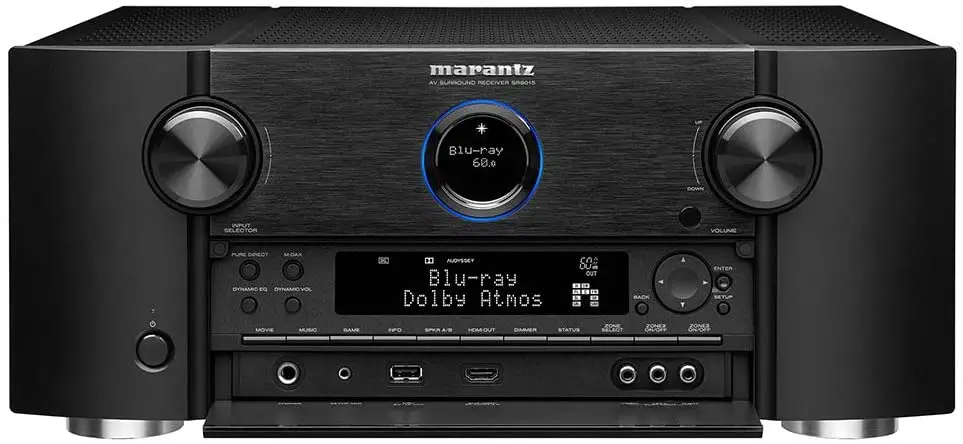
Now in terms of layout we get the usual two knobs configuration with the right one for the volume and the left for input selection while under the right one we find the IR sensor. On the lower left there is a single circular button for powering the unit while everything else is hidden behind the front hatch.
Opening this hatch we are presented with a plethora of control buttons as well as with a second display screen that provides more detailed information than the circular top one. Looking at all the available buttons we see that the SR8015 has exactly the same layout as the SR7015 so no changes here. On the left we find a group of four buttons for Pure Direct, the MDAX2 audio enhancer and Audyssey Dynamic EQ and Dynamic Volume features while on the right side of the screen there are the usual menu navigating buttons.
Under the screen there is a thin line with 11 buttons for various functions like sound modes, zone 2 control, status, HDMI and dimmer among others. Under these we get all the frontal ports which include a headphones jack, the microphone input for audio calibration, a USB port for connecting external storage, an HDMI port for easy connection of input sources, a composite video input along with 1 analogue stereo input covering all the basic connections you may need to have easy access to.
One of the things we like here is that the SR8015 retains the front HDMI port that is missing from the smaller models. Hopefully Marantz will bring this back in the future as it is such a practical feature and we we very disappointed to see it being removed in some of their units.

In terms of internal components the SR8015 comes with everything we saw in the lower models and spices things up a bit. And so once again we find the familiar 32-bit DACs that are responsible for all audio conversions, it features Marantz’s proprietary Hyper Dynamic Amplifier Modules (HDAMs) that deliver ultra-wide-band response and detailed reproduction as well as current feedback circuitry and Hybrid PLL Clock Jitter Reducer for optimum fidelity and maximum dynamic range.
Along we get high-current discrete power amplifiers with low-impedance drive capability but for the SR8015 we also find a toroidal power transformer, that in theory should be more efficient than the ones used in the cheaper units, and also comes with a copper plated chassis for better isolation of its internal components.
As for its remote the SR8015 uses a different design than those found in all the other Marantz receivers but if you look closely its layout is extremely close to the one used with the SR7015 with minor differences. The remote has code name RC045SR and with a considerable size and a number of buttons higher that what we would like it is not the most easy going remote you can find. It has its buttons made out of rubber that have good distance between them although some of them are far too small and not easily pressed.
Buttons placement follow more or less the standard layout and as such at the top we find all the input sources, navigation and volume control under them, a group of playback buttons below, four smart selection buttons beneath and we finish at the bottom with the four sound modes and numerical buttons.

There is also a backlight function by pressing the side button which is practical but we would definitely prefer it to be motion sensing. The only major difference from the SR7015 remote is that this one comes with a screen on top, although honestly we fail to see the reason behind including one.
Overall quality of the SR8015 is extremely high. The design with its circular display you either love it or hate it but in terms of quality it misses nothing a Marantz flagship should have.
Audio Quality
Being Marantz’s flagship the SR8015 offers the most complete support, when it comes to audio formats, you can find in an AV receiver today. As such we get the usual Dolby Atmos and DTS:X along with the standard Dolby Surround and DTS Neural:X up-mixing technologies that can upmix simple stereo audio tracks into full immersive surround sound.
We also get the usual support for virtual tech with DTS Virtual:X and the now standard Dolby Height Virtualization. What these virtual technologies do is that they can create virtual speakers in space where there are no actual speakers present and create the illusion of sound with the use of special algorithms and processing. This can be very handy if you cannot place speakers in certain areas like on the ceiling for example. Obviously the result is in no way the same as having actual speakers but it can be a good alternative in many cases.

One thing that is worth noting is that Dolby Atmos Height Virtualization can be used for both Dolby Digital as well as DTS audio tracks. On the other hand DTS Virtual:X can be used only with DTS tracks and as a result Dolby’s offering seems to be getting the upper hand on this. Also if you want to enable the Dolby Atmos Height Virtualization it can be a bit tricky to find out how to do it as there is no direct button that can enable this.
In order to enable it you will have to first go into the main menu, in the Audio section and find the surround parameter. In there you will find the Speaker Virtualizer that you have to enable first and after use one of the sound modes that uses Dolby Surround. This way Dolby’s Virtualizer will be enabled. Obviously if you haven’t done this before it may seen slightly confusing at first but this is the way to do it.
But except from the two usual object oriented formats the SR8015 has added support for DTS:X Pro which is similar to DTS:X but supports more speakers, IMAX Enhanced and also Auro-3D. So in essence you get everything commercially available at the moment.
The SR8015 supports up to 11 channels with its built-in amplifiers with a theoretical 140 watts of power (8 ohm, 20 Hz – 20 kHz, 0.08% 2ch drive). The receiver is capable of powering dual subwoofer setups, obviously, as almost all AV receivers can do nowadays. With the supported channels you can create up to a 7.2.4 channels Dolby Atmos audio setup. The receiver can process up to a maximum of 13 channels so in case you add an external 2 channels amplifier you can go for either a 7.2.6 channels or a 9.2.4 channels system.
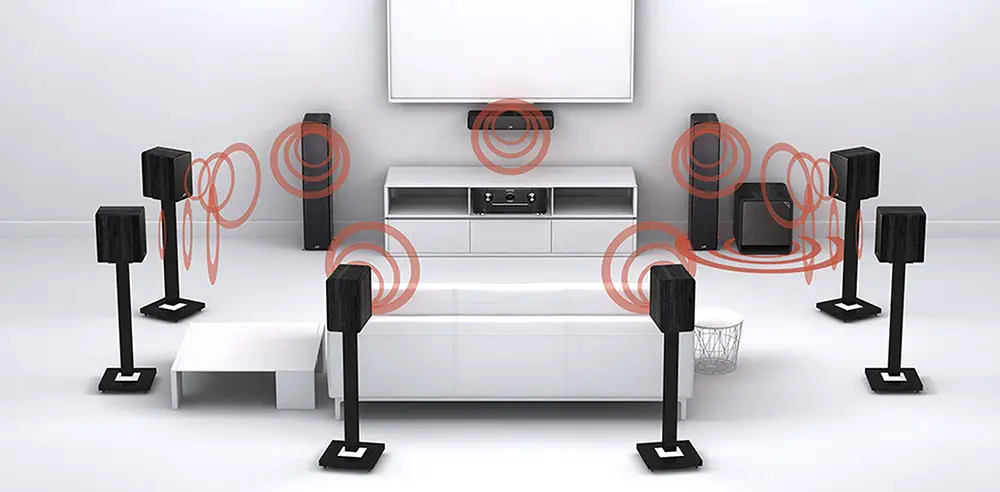
For this review and as we always do when we get a receiver that can support it we went for a 7.1.4 channels setup with a single SVS SB-2000 Pro subwoofer that was placed at the front left corner of our testing area and four ceiling speakers for the Atmos overhead layer. Our testing movie this time was the new Dune in 4K UHD which features a grand Dolby Atmos mix.
The receiver has no lack of power and it shows this immediately from the opening shots. We fast forward to the encounter of the first sandworm and the SR8015 makes this scene feel so epic. Overall the front sound stage suddenly was brought to life with excellent handling of all elements. It was almost as if the sandworm would emerge in our testing room.
Dialogue was clear and very distinct. During the ornithopter flight, even when the sandworm was ready to shallow the spice harvester every line of the actors was distinct and very much isolated in the center with no overlapping with the rest of the effects. Voices had good articulation and very natural tone.
You cannot talk about Dune and no mention its amazing surround performance. Thankfully the receiver did an excellent job at rendering everything with detail and pinpoint precision. During the attack on Atreides home base blasts and explosions could be heard all around us. When Paul and Jessica fly an ornithopter through a sandstorm with missiles tracking them you are hit with a visceral 360 degrees activity.
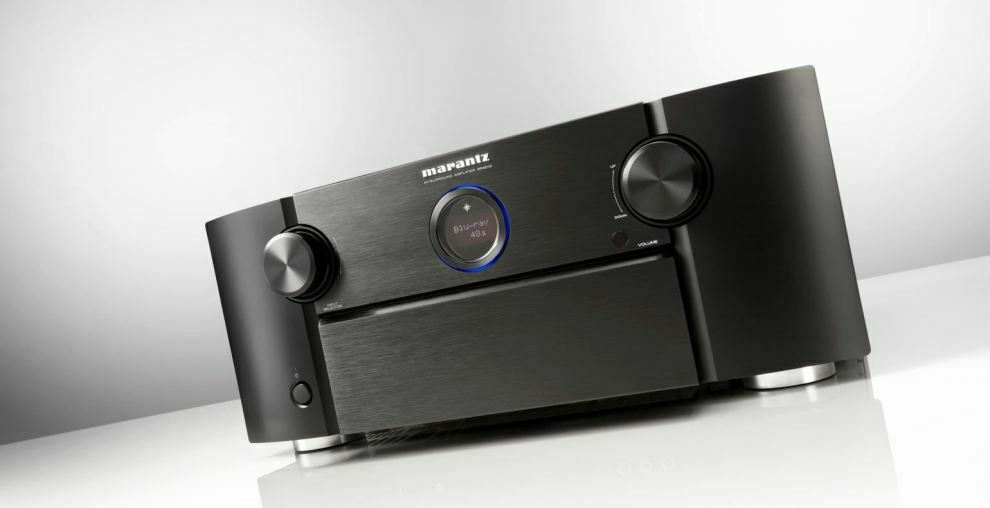
Equally impressive as the surrounds was the Atmos performance. The four height speakers added the necessary height and surely upped the overall experience even more. With Dune’s grand size scenes and structures the added extension above us gave us a better sense of size and magnitude. Obviously Atmos effects were not so much obvious or to the face as surrounds but the receiver rendered everything above us with great detail and excellent handling.
On the low end the SR8015 made no compromises and in combination with our subwoofer we were constantly hit by a low end madness. From the raw sound of the ornithopter’s engines, the flapping of their wings, Atreides transport freighters to the destruction of their home base and headquarters everything sounded perfect. The receiver fed our subwoofer with all the low end information necessary and surely kept us in the edge of our seats. Such a film deserves the best in bass activity and the SR8015 is a masterful handler in that front.
With 140 watts of power the SR8015 has enough juice if you like to push the volume into unsettling levels. Obviously the more speakers you have connected the less the power output so in this case the pre-amplifier mode can work for you as you can connect better external amplifiers in order to push your system to higher limits. But the internal amplifiers were enough from what we used it for, and at least for our standards.
Marantz AV receivers are famous for their musicality and the SR8015 retains all the characteristics that made the previous models so good in this regard. As such this receiver supports not only the usual lower quality audio formats like MP3, WMA (up to 192 kbps) and AAC but can also playback High Resolution Audio in the likes of FLAC, ALAC and WAV files up to 192 kHz / 24-bit quality. DSD streaming is also available for both 2.8 and 5.6MHz as usual.
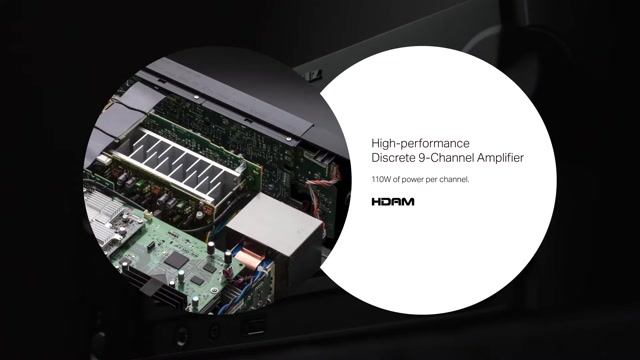
For this testing, as we usually do, we selected a few favorite tracks in FLAC format that we streamed through the front USB port for the best quality possible. Most Marantz receivers have more or less the same kind of sound signature and tonality as they have similar internal components. And the SR8015 is no different and as we have tested all the previous 2020 Marantz releases we knew more or less what to expect here.
The front sound stage was every bit as good as we were expecting it to be. We could really be writing thousands of words here in trying to describe the receiver’s performance but what the SR8015 can do must be heard in order to appreciate its real capabilities. Every detail was rendered faithfully, every instrument was reproduced naturally and everything was placed in space with pinpoint accuracy. The front channels had perfect separation while stereo panning effects felt impressive as ever.
Vocals carried all the right emotions in them. Anger, sadness, anxiety, happiness…it’s as if you could feel the emotional state of the performer. The mid-range was rock solid keeping everything tight together while the bass had exactly the desired weight to it. Not too excessive and not too flat. It’s as if it knew exactly the right balance for the perfect result.
Just for the heck of it we tried a few different genres, although we already knew what to expect. We changed from jazz to pop, after rock, some classical, we threw some electronic and finished with some AC/DC just for good measure. It was as if the SR8015 was mocking us in our try to abuse it with songs we thought will bring it to its limits. Alas it didn’t break a sweat. The Marantz was standing there like a rock waiting to handle with care the next bits we would throw at it. Simply amazing.

The SR8015 is an amazing AV receiver either for movies or music. Surely purists prefer to go for separates but if you are the kind of guy that prefer to have everything in one box then you cannot go wrong with this one. It’s just amazing no matter the source material.
Ports and Connectivity
Next we will be looking at all the available ports the unit comes with. We already mentioned above that under the opening hatch at the front we got a headphones jack, the test microphone port, a USB port, an HDMI input, a composite video input and an analogue stereo audio input which is pretty much everything you will need.
The SR8015 is an impressive sight with its huge number of ports but we question the need for such a huge number of legacy ports like stereo inputs and composite/component ones. To have some in case of need yes, but to include so many of them when HDMI is the prevalent port used in most of today’s systems is a bit too much in our opinion.
First of all we find 13 speaker terminals but as the receiver has only 11 discreet amplification channels you never use all 13 terminals at the same moment. For a 13.1 channels setup you will need to use an external 2 channel amplifier. We also get 7 HDMI inputs (not including the front one) and an impressive 3 HDMI outputs with all three of them being 8K/HDCP 2.3 enabled.
Unfortunately, as with most 2020 Marantz receivers, from the 7 HDMI inputs only one is HDMI 2.1. The new port brings with it a vast range of existing and new features that includes 8K/60Hz and 4K/120Hz pass-through capability, 4:4:4 Pure Color sub-sampling, Dolby Vision, HLG, HDR10, 21:9 video, 3D and BT.2020 pass-through, HDR10+, Dynamic HDR, ALLM, VRR, QMS, QFT, ARC, eARC, Auto LipSync and HDMI-CEC.
Now there is another thing we need to mention here about the HDMI 2.1 ports being used in all 2020 Marantz receivers including the SR8015. If the receiver was manufactured before May 2021 the Panasonic chip that handles the HDMI 2.1 connection cannot process the signal of specific sources that output at 4K/120Hz RGB signal (8-bit, 10-bit, 12-bit) like the Xbox Series X and this results in a black screen. Now there are not many sources that currently support 4K@120Hz with this exact configuration but this is purely a hardware issue and cannot be solved by a simple firmware update.
Now if you are wondering, the SR8015 has no problem whatsoever if you are watching movies or playing games at 4K/60Hz and 4K/120Hz YCbCr 4:2:2 signals (32Gbps) or anything below that so in most cases you are going to be absolutely fine. This means that the PS5 will work without any problems. In the rare case where the receiver accepts a 4K/120Hz RGB signal (8-bit, 10-bit, 12-bit), like from the Xbox Series X for example, this is when this problem will appear.
Sound United had announced that most Denon and Marantz AV receivers that were manufactured after May 2021 would come with an updated HDMI 2.1 chip that doesn’t have this problem. But if the receiver was manufactured before this date it probably has the original HDMI 2.1 which means this would need a different solution. For those pre-May 2021 receivers what Sound United has decided to do is offer, free of charge, an HDMI adapter called SPK618 that is handling the HDMI input signal and converts it in one that these receivers can handle. As such the SR8015, with the use of this adapter, can accept even signals from the Xbox Series X without any problems.
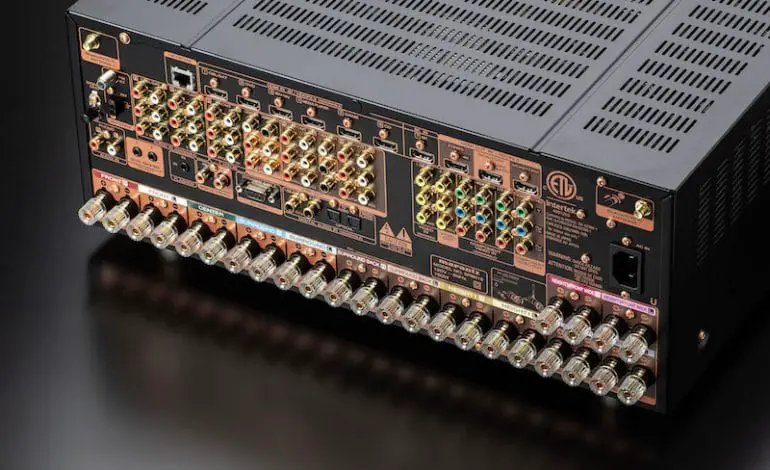
Now, in order to know if the SR8015 you have, has the old or updated HDMI 2.1 chip there are actually two ways. The most obvious one is to connect an Xbox Series X and see if you get a black screen or not. But you can determine this by the serial number of the receiver also. Sound United stated that all models that end with 70000 and onwards are free of this bug and you should in theory be ok.
But in case your receiver is older then you can head to Marantz’s website and fill in the form to receive this adapter for free. Our test unit was an older model with the bugged HDMI 2.1 port so in our case we did try the SPK618 adapter and it worked fine connecting an Xbox console.
As for everything else we get 6 analogue stereo inputs, 1 dedicated analogue input for PHONO, 2 composite video inputs and 2 outputs, 3 component video inputs and 1 output, 7.1 multichannel coaxial inputs, 13.2 multichannel Pre-Outs, Zone 2 and Zone 3 outputs, 2 digital coaxial audio inputs and 2 optical ones, an Ethernet port, 1 remote control input and 1 output, 1 IR flasher input, an RS-232C port, 2 12V trigger ports as well as dual WiFi and Bluetooth antenna connectors. The receiver does not come with FM/AM ports, instead there is the option to connect an external tuner for that purpose.
Wireless connectivity seems to be the same as all its other 2020 releases as it has built-in WiFi that supports both 2.4 and 5GHz as well as Bluetooth for streaming audio as the SR8015 comes with v4.2.
The SR8015 has many ports to work with and it will be surprising if you even use half of them. If there is one thing missing that would be XLR ports but other than that it has everything. Obviously more HDMI 2.1 inputs would be great but for that you will either have to wait for the new 2022 models or buy a separate adapter that Sound United created that includes 3 HDMI 2.1 inputs for you to use code named Marantz VS3003 pictured below..
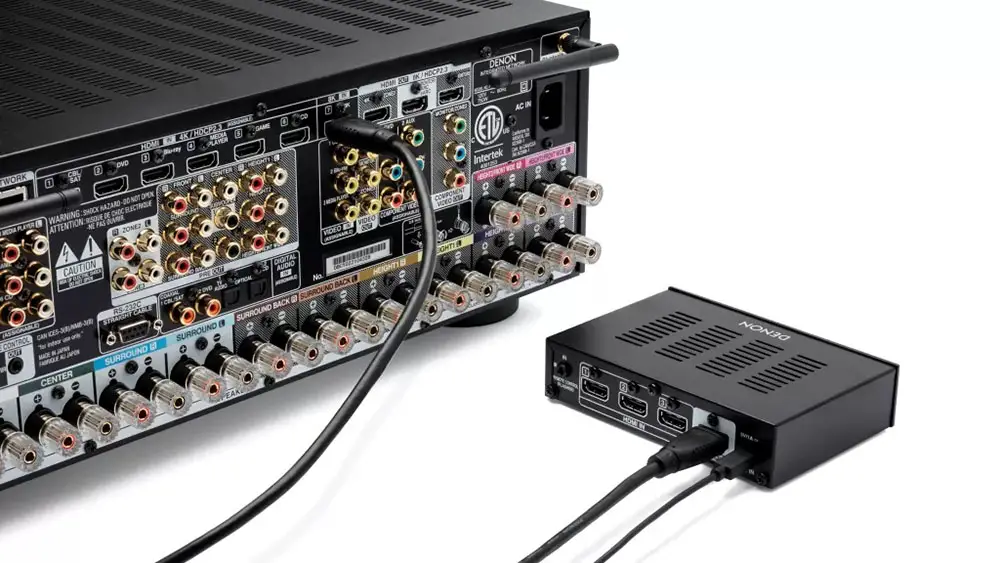
OS, Apps and Features
In terms of extras the entire SR lineup of 2020 comes with exactly the same features with some minor changes here and there so this part of our review is basically the same as what we observed in our other Marantz 2020 AV receiver units while we will point any differences where we see them.
If you have not much experience calibrating an AV receiver by yourself then you can use the built-in system that is no other than the Audyssey MultEQ XT32 variant which is the most advanced Marantz offers in their units. The XT32 is similar to the XT variant as it features more measurement positions but also comes with higher filters resolution and thus can offer better overall results.
The AV receiver comes with a calibration microphone and by using the built-in wizard that guides you step by step you can achieve very good results without the need to manually do any changes which can be very handy for casual users. As always for the best results a manual calibration is the best but from what we have seen the Audyssey system is an excellent assistant for novice and inexperienced users and the XT32 edition featured in the SR8015 is very capable at offering very good results for any situation.
Along with the Audyssey system there are a few more features that are included in the suite with the Dynamic EQ being one of them that keeps the dynamic levels as well as clarity even at low volume. The second feature that is included is the Dynamic Volume that balances sudden volume spikes when there are shifts between TV programs and commercials.
There is also Audyssey LFC that uses advanced psychoacoustic algorithms to deliver more full-range balance, including deep bass, without disturbing neighbors or people in other rooms of your home and lastly Audyssey Sub EQ HT that provides individual DSP tailoring of each subwoofer in a dual subwoofer setup for deeper bass with improved definition.
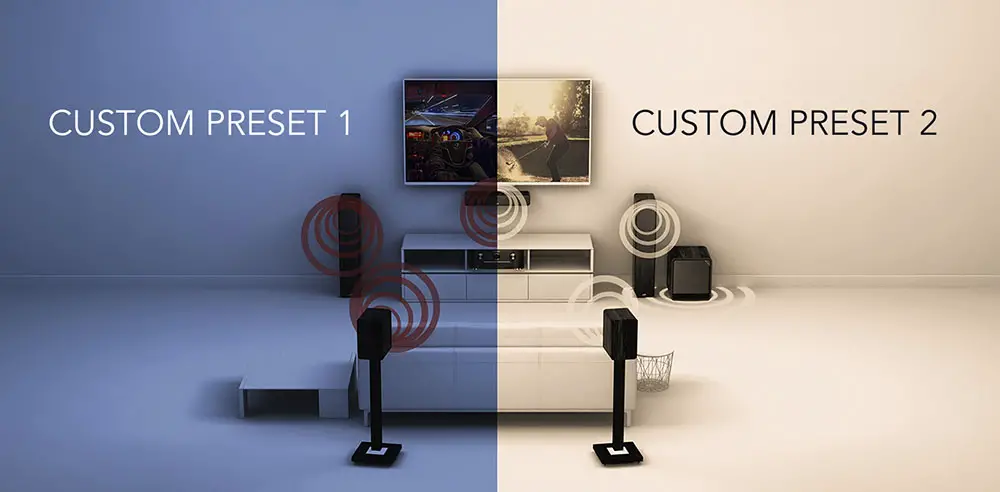
A 2020 feature that many of Marantz receivers share is the new two presets saving function. This gives the receiver the ability to store two Audyssey settings and switch between these two on the fly, giving you the freedom to tweak your listening experience based on content or listening environment. This can be especially handy if you like to watch different types of films and want to have a setup created specifically for each type.
Now if you are a more advanced user and want to get the maximum out of the receiver you can dig deeper into calibrating your system with the help of Audyssey MultEQ Editor App that can be downloaded for iOS and Android devices and make all calibrations from there. The app has more settings and features and you can do much more with your system than you would otherwise. The only minus of this, is the price as the app has a one time fee that you need to pay in order to download which is a shame considering the premium price you already pay for this unit. In our opinion they should at least provide a download voucher for their top units as a thank you for buying such expensive equipment.
But Marantz has another app available and this one is free of charge called “Marantz 2016 AVR” remote app and with this you can have total control of the SR8015 from your mobile device. We had checked this app before in some of our previous reviews and we found it pretty good so since it’s free you can try and see if you like it. The only minus of the app, at least in our case, is that it fails to update or transmit certain commands we gave it.
In terms of menu interface and settings everything remains the same as we have been used lately. All menus are separated into categories according to their appropriate functionality and everything was easy to find even with so many settings and features available. Nothing worthy of noting here really although we would love to see a more modern UI at some point in the future as the one Sound United uses looks and feels archaic.
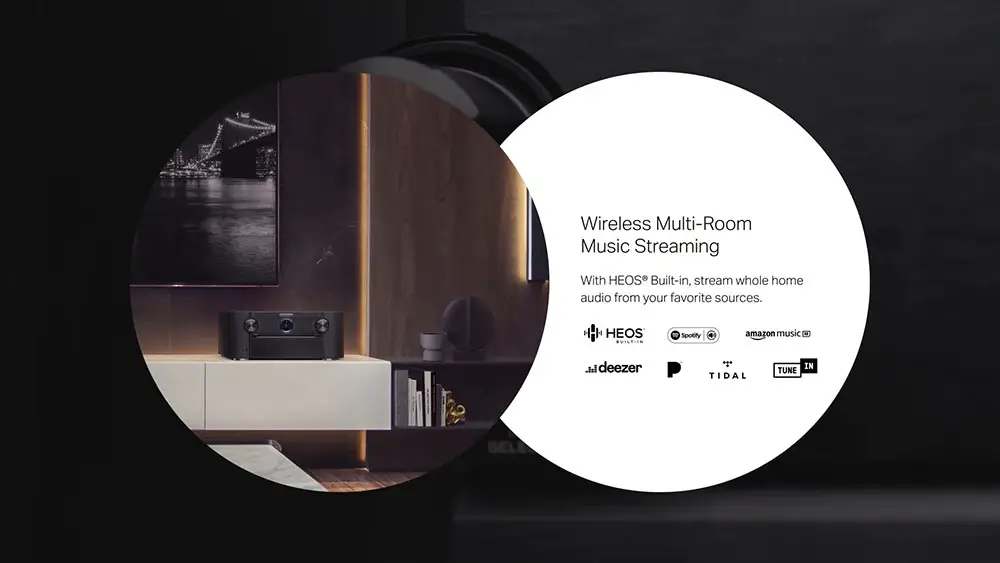
All Marantz receivers, including this one comes with an ECO mode that you can enable and let the receiver manage its power output in order to achieve power economy. But if you want the unit to perform at its peak power at all times then we suggest you to better leave this setting turned off. We would only recommend this if your unit becomes really hot and you have no other way of cooling it down, then this could potentially help a little. But as we mentioned earlier in our review the best way to cool it down is to use an active cooling solution like the AC Infinity AIRCOM T8.
Moving onto streaming the SR8015 has the ability to stream content locally if you have a network server like a NAS connected or through the internet from one of the available streaming services available. The list is pretty extensive and includes all the big names like TuneIn Internet Radio, Spotify, Pandora, SiriusXM, Amazon Music HD, TIDAL, Deezer, iHeart Radio, Napster, Soundcloud and Mood Mix just to name a few.
With the receiver supporting both wired as well as wireless connections (2.4GHz and 5GHz) you can choose what is best depending on your house configuration and what is best for your situation. But streaming capabilities don’t stop there as with Airplay 2 you can stream music from Apple devices through the use of Bluetooth in case you prefer Apple’s solution.
And since we mentioned Bluetooth we should note that a new feature that has been added to many of 2020 models, including this one, is the ability to stream audio to Bluetooth enabled headphones. And not only this as you can now output sound from both the wired speakers and to a Bluetooth headphones at the same time.

The only minus we can see in Bluetooth transmission is that there are bound to be lip-sync issues as the Bluetooth codec being used is the usual SBC that doesn’t have the same low latency as some other codecs like aptX for example. As such this feature can be good for music listening but not so good when used for films.
As the unit supports USB streaming it is pretty essential that comes with M-DAX2 support. Compressed music enhancement in the SR8015 is done by Marantz MDAX2 technology. The use of compressed audio files like MP3, Windows Media Audio or AAC is the norm nowadays. The audio quality of these compressed files however is less than what is found in the original lossless files on a CD, especially lacking in the higher frequencies and affecting the lower frequencies which make the audio image less wide and deep.
The Marantz Digital Audio Expander 2, also called M-DAX2, recalculates the outputted frequency range. This enables you to get a more detailed and clearer sound. The result may not be as good as some high resolution audio files but any improvement is a welcome one.
Now let’s see what is there in terms of multi-room capabilities. No changes here either as the receiver gets the HEOS multi-room audio technology that you can use in order to connect the SR8015 with other HEOS enabled speakers you may have around your house. As an alternative there is also Airplay 2 that does exactly the same job with speakers that are Airplay 2 enabled. And while streaming has definitely become the normal nowadays when it comes to multi-room environments the receiver also supports Zone 2 and Zone 3.
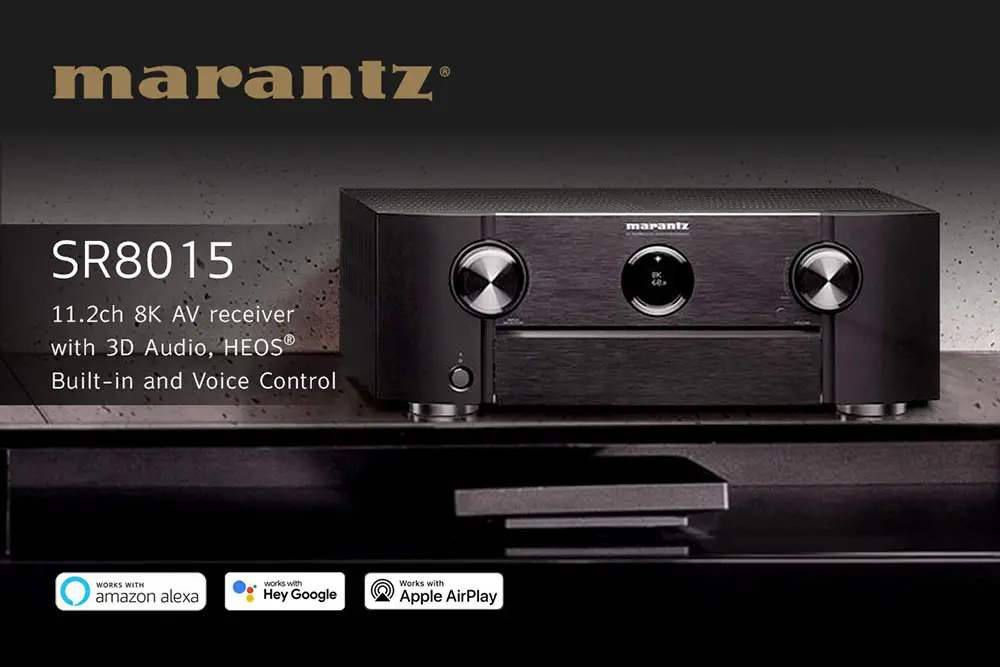
Marantz has not left voice control out of its feature list and remains the same as always as we get not only the two most known services being Amazon Alexa and Google Assistant but also Apple Siri through the Airplay 2 app and Josh.ai. All of them need their respective external devices to be used obviously but it’s good to see that Marantz offers full support for the last few years now and it has become a standard nowadays in their entire lineup.
Another feature that Marantz seems to favor year after year among their releases is strong custom integration capabilities and the SR8015 continues this trend. The unit features external RS232, IP and Web control capabilities for easy customization and compatibility with third-party integration solutions. There is also IP control capability for major third-party control devices, as well as Control4 SDPP (Simple Device Detection Protocol) certification for seamless integration with Control4 home automation equipment.
IR (infrared) remote control input and output are included on the rear panel for remote control compatibility with other components in your home theatre system. As a result the SR8015 is a great option for all custom installers.
A new 2020 feature among many Marantz receivers seems to be the Pre-Amplifier Mode with which this unit can work as a perfect AV pre-processor with the latest HDMI connectivity. Pre-Amplifier Mode provides a cleaner signal path and more tolerance in clipping level by disconnecting internal amplifiers.
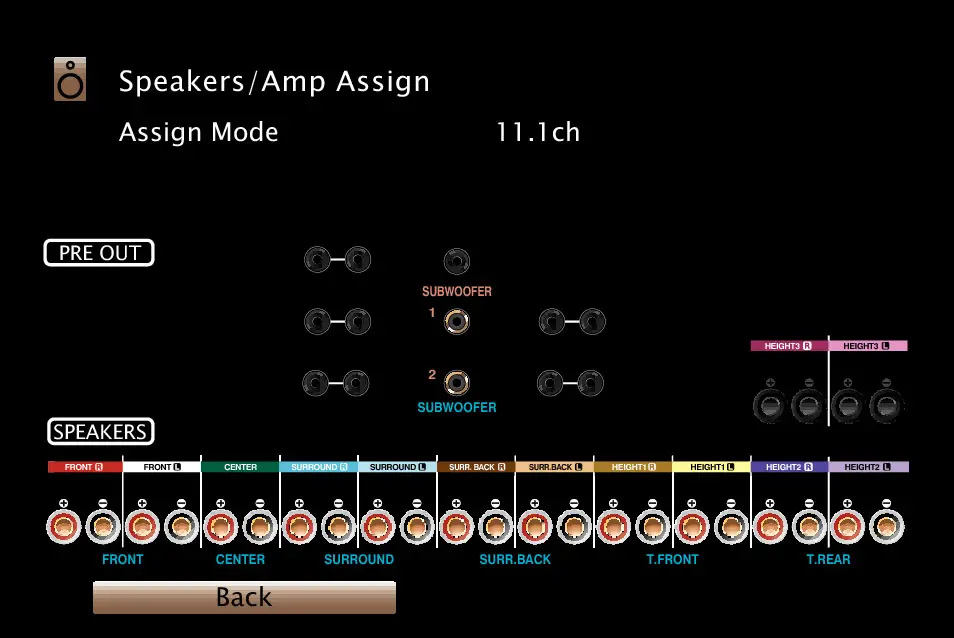
We mentioned before that although we like the addition of new features this seems to be a rather strange one to have here. Usually anyone that buys an AV receiver does so for the convenience of having all in one box. Those that prefer separates will definitely go for a processor plus amplifiers so we don’t see the reason why someone would purchase the SR8015, or any AV receiver with this feature for that matter, to use this mode in parallel with external amplifiers.
But there are many more features in the receiver that are worthy of mention and these include HDMI-CEC functionality, analogue and HDMI to HDMI upscaling up to 8K@50/60Hz resolution, Bi-amp capabilities while the unit is also “Roon Tested” certified. Now we need to clear some of the confusion here as there are two types of certifications and many people don’t know the difference between them. The two types of certification are Roon Ready and Roon Tested.
The SR8015, as with all the other Marantz receivers, is Roon Tested which means that it doesn’t have Roon built-in but has been tested to work but not without a small catch. And that is audio quality. As this works through Airplay streaming, audio quality is limited to only 16 Bit/44.1kHz. Keep that in mind in case Roon is specifically important to you but also want your files to be streamed in their original high quality.
The entire SR lineup comes with exactly the same feature set and the SR8015 has them all as any real flagship should be.
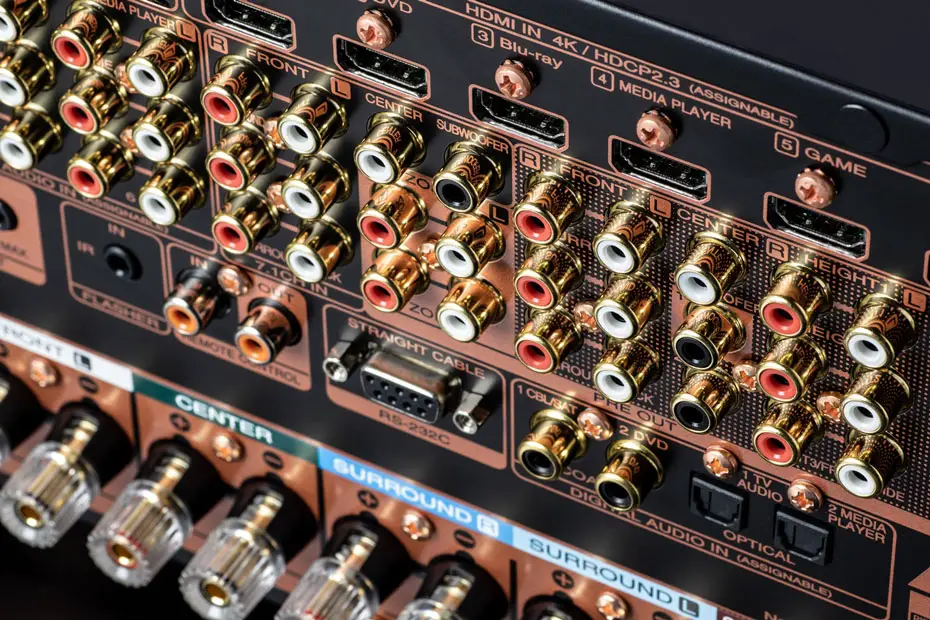
Final Thoughts
The SR8015 is a worthy flagship and has everything such a title brings with it. Marantz needs no introduction and for one more year they show the standards that they have built their reputation on.
The SR8015 has everything you would expect from such a top-tier unit and even more. Plenty of power, support for all commercially available sound formats, excellent sound output and an extensive list of features that are enough to satisfy even the most demanding of users.
Are there any downsides to such a beast? Not much to say here to be honest. We are surely going to nitpick but when you pay such a premium price then surely you expect only the best. The HDMI 2.1 bug for the pre-May 2021 models will surely leave a bad taste in the mouth, as is the inclusion of just one HDMI 2.1 port.
Both of them have been addressed by Sound United but the fact remains that these are issues of the main unit. We would also love to have a motion sensing backlight remote while adding a cooling solution to keep the temperatures down surely adds more cost to an already high enough price tag.
In the end if you prefer to have everything in one box and aim towards the premium category then the Marantz SR8015 is definitely one of the best choices you can make. It’s a serious piece of audio equipment and will definitely offer you a cinematic audio experience that is one of its kind.
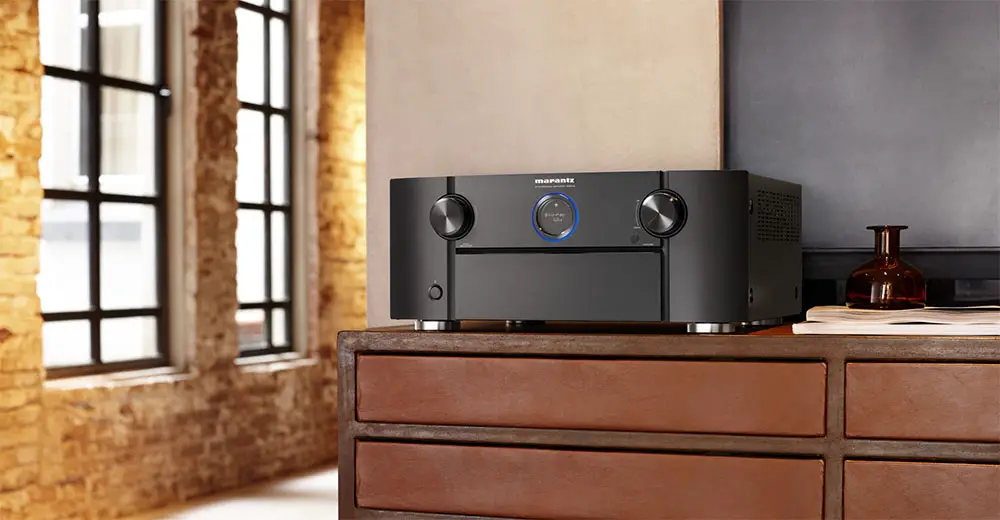
For more reviews you can check our dedicated 11 channels 8K AV Receiver reviews list or even look at our Product Reviews Table where you can find the brand and specific product you are looking for.
Cheapest Places to Buy :
*We are a reader-supported website. When you buy through links on our site, we may earn a small affiliate commission at no extra cost to you. Home Media Entertainment does not accept money for reviews.*
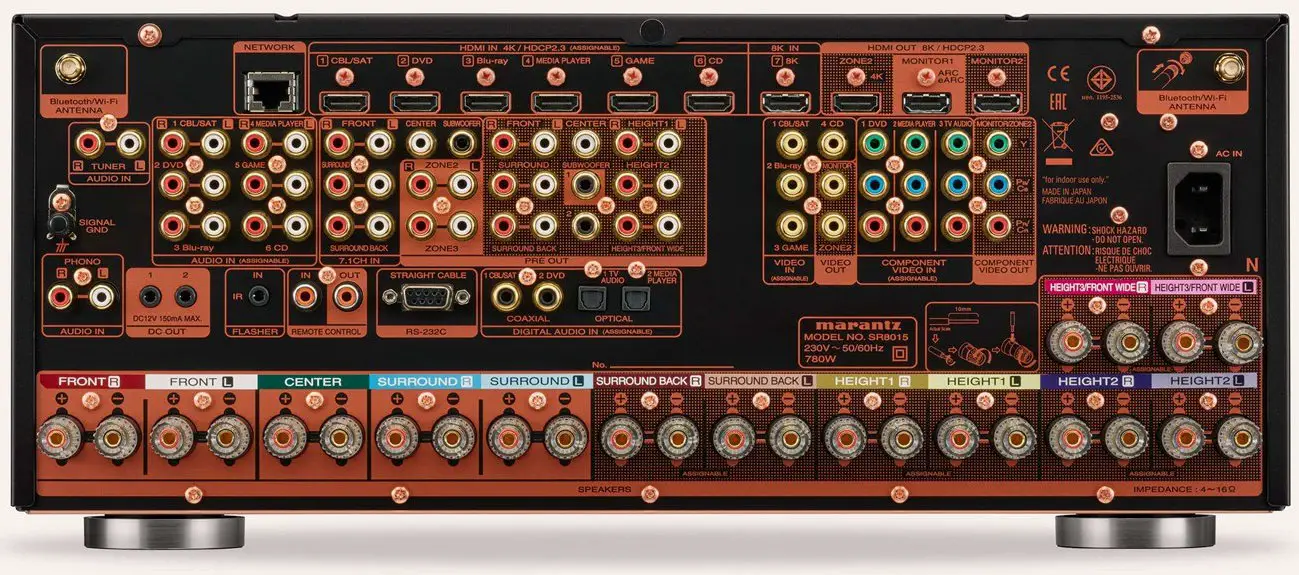
I am between this one and the Yamaha RX-A8A which is also 11.2 channels but can’t decide which one to go for. I like the Yamaha for the bug free HDMI ports but I always favored Marantz for its more pleasing to my ears sound output. Any help which one to go for?
That’s a tough one. In fact I am preparing my RX-A8A review so you can read all about it. Both of them are really great and it’s not an easy decision. Each one has specific strengths but when it comes to what matters the most, and that is cinematic performance they fare very close. So I would say that you should choose mostly based on what specific features you are looking for rather than overall sound performance.
Amazing receiver except from the HDMI 2.1 bug and the single HDMI 2.1 port. I was definitely looking at getting it but in the end I decided to wait to see if the 2022 releases will fix both of these issues. Summer cannot come soon enough! I hope I am not waiting for nothing.
Judging by some of Yamaha’s and Onkyo’s releases and also by the updated Sound United units I assume that the 2022 refresh releases will be surely HDMI 2.1 bug free. Now how many HDMI 2.1 ports they will come with this remains to be seen but they should in theory have more than one.
Hello Stratos,
Thorough review, thank you for that. I can’t help but noticing for the previous reviews of the lower tier Marantz SR’s you explicitly mention the AKM DAC’s. Now you only refer to ‘the familiar 32 bit DAC’s’. I’m considering buying a new AVR and have narrowed down to Denon 6700, Marantz 8015 and the new Yamaha. Now I read this rumors Denon and Marantz have changed the AKM DAC for a TI (Burr Brown) lower grade DAC. Probably it wouldn’t really matter in the chain of input – throughput – output (amplification causing most impact on THD+N) but If I pay this amount of money I would not be happy with downgraded DAC’s. Did you experience anything giving you cause for concern ?
Hello Bram. I understand your concerns and there is a lot of talk about Sound United changing the DACs in some of their latest batches. That’s the reason why I changed my article because some may still use the AKM DACs while some newer ones may not.
Now I will be clear here to say that I didn’t have a chance to compare two similar AV receivers that come with these different DACs so what I am saying here is my speculation. In theory and with some advanced testing equipment there may be some differences in the numbers two similar AV receivers but with different DACs would produce but in reality and with no equipment available I would be very surprised if anyone would be able to hear the difference at all.
Yeah I get that we pay a premium and we always want to get the best for what we pay for. That’s why all this fuss happened after all. And I agree with it. But in the end, if you can’t hear the difference and if the change has little to no effect in the end quality does it really matter? In my opinion it does not. So my clear answer to your concern is that you shouldn’t really be worried by this and buy the unit you really want to and try to enjoy it to the full. I guarantee you that it will not disappoint you.
I switched my sr7008 to sr8015.
It’s amazing output I got.
Hey Sunil. Thank you for your input and comment. Wish you all the best!
Hi Stratos, I currently have Denon AVR X-4700H. Shall I stick with it. Or Is it going to be a good upgrade for me if I switch to SR-8015?
Thank You
Hello Nagesh. It really depends. Is there something you need that the 4700H does not have? Because the SR8015 is in a different category than the 4700H. So if you need more channels then obviously such an upgrade makes sense. Always when you want to upgrade you have to ask yourself, what is it that you need that your current equipment does not offer. If you can answer that then you know the answer to your question!